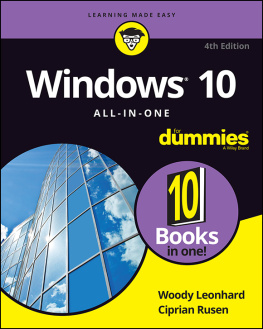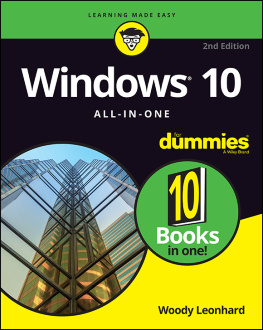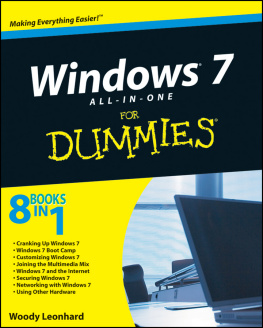Robert Leonhard - The Art of Maneuver
Here you can read online Robert Leonhard - The Art of Maneuver full text of the book (entire story) in english for free. Download pdf and epub, get meaning, cover and reviews about this ebook. year: 2012, publisher: Random House Publishing Group, genre: History. Description of the work, (preface) as well as reviews are available. Best literature library LitArk.com created for fans of good reading and offers a wide selection of genres:
Romance novel
Science fiction
Adventure
Detective
Science
History
Home and family
Prose
Art
Politics
Computer
Non-fiction
Religion
Business
Children
Humor
Choose a favorite category and find really read worthwhile books. Enjoy immersion in the world of imagination, feel the emotions of the characters or learn something new for yourself, make an fascinating discovery.

- Book:The Art of Maneuver
- Author:
- Publisher:Random House Publishing Group
- Genre:
- Year:2012
- Rating:3 / 5
- Favourites:Add to favourites
- Your mark:
- 60
- 1
- 2
- 3
- 4
- 5
The Art of Maneuver: summary, description and annotation
We offer to read an annotation, description, summary or preface (depends on what the author of the book "The Art of Maneuver" wrote himself). If you haven't found the necessary information about the book — write in the comments, we will try to find it.
The Art of Maneuver — read online for free the complete book (whole text) full work
Below is the text of the book, divided by pages. System saving the place of the last page read, allows you to conveniently read the book "The Art of Maneuver" online for free, without having to search again every time where you left off. Put a bookmark, and you can go to the page where you finished reading at any time.
Font size:
Interval:
Bookmark:
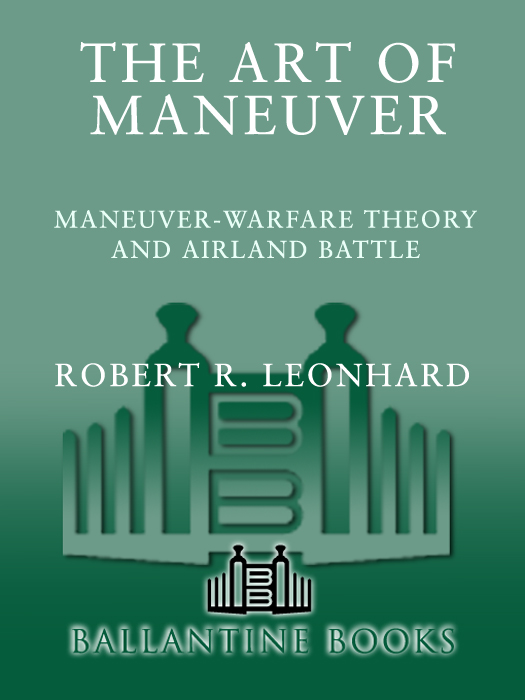
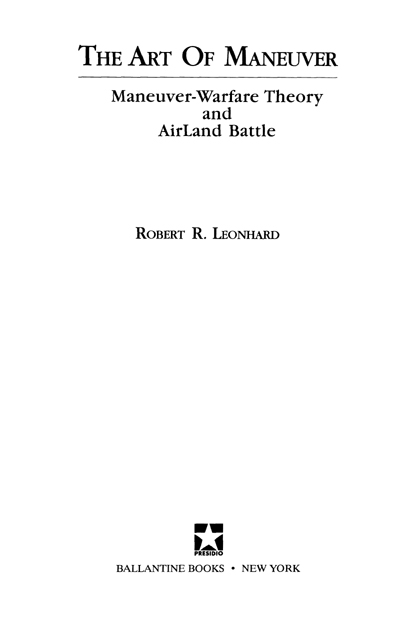
The opinions expressed in this book belong solely to the author and do not represent the official opinion of the United States Government or of any branch of the government.
A Presidio Press Book
Published by The Ballantine Publishing Group
Copyright 1991 by Robert R. Leonhard
All rights reserved under International and Pan-American Copyright Conventions. Published in the United States by The Ballantine Publishing Group, a division of Random House, Inc., New York, and simultaneously in Canada by Random House of Canada Limited, Toronto.
Presidio Press is a trademark of Random House, Inc.
www.ballantinebooks.com
Library of Congress Cataloging-in-Publication Data
Leonhard, Robert R.
The art of maneuver : maneuver-warfare theory and airland
battle/by Robert R. Leonhard.
p. cm.
Includes bibliographical references.
eISBN: 978-0-307-51327-4
1. United StatesMilitary policy. 2. Maneuver warfare.
I. Title.
UA23.L482 1991 91-12820
355.42dc20
v3.1
For Carolwife, lover, friend,
and fellow student of maneuver
Ive been interested in military history ever since I was a boy. Before I began my career as an army officer, though, all my reading was solely for my own pleasure. I could leisurely choose which great captains to read, which battles to relive, and I had little interest in the theory of war because the stories of its conduct were more captivating.
But my most recent assignment in the army demanded a different perspective. As a combat developer for the army, I worked with my fellow soldiers and civilians on developing the force (the infantry force in particular) of the future. A big part of that development revolves around the subject of fighting doctrine, and as a result I became a student of the theories of war. My new reading curriculum consisted of two categories: army doctrine (both current and future concepts) and my own personal reading. For the latter I began to choose those works by which I could trace the evolution of warfighting doctrine throughout the ages.
It gradually became clear to me that there was a disconnect. Our doctrinal manuals persistently claim that we are a maneuver-oriented army. Id heard that term throughout my career, and to a young infantry lieutenant, it conjured up images of my armored personnel carriers (APCs) charging into battle while the artillery crashed around us. But to apply the term to future developments, I needed a somewhat more sophisticated definition. I turned to the classics for help.
But I could discern little of what the classics were talking about in our doctrine. In fact, often the two sources, our doctrine and established military theory, were diametrically opposed on the question of how to defeat an enemy in war. Thereupon, I set out to definefor my own satisfaction at leastwhat the term maneuver warfare really meant (if it meant anything at all). I searched again the many books I had read and sought out new ones, always with the purpose of finding those principles of war that led to the defeat of the enemy through maneuver. I was not looking merely for crafty or successful commanders of the past, but rather for principles. The result of my research is part one of this book.
Having satisfied myself that I understood what maneuver warfare isand even more importantly, what it is notI embarked upon a reexamination of our fighting doctrine, AirLand Battle. The study was especially relevant to me because I had spent most of my career as a troop leader striving to understand and apply the tenets and imperatives of the new concepts. But I began to note, both in our published doctrine and in the embryonic concepts I saw developing, that quite often lessons and principles from the past seemed to be ignored. When I sat down to analyze the theoretical foundations of how my army fights, I became somewhat dismayed at my findings, but all the more interested just the same. It seemed to me that if there were any serious theoretical foundation for our doctrine, it could not have come from past military principles of maneuver. I determined to discover the guiding principles and thoughts behind the way we fight. The results of my study are found in part two.
I must hasten to disclaim any intent toward iconoclasm. Although I have tried to remain free from bias, my conclusions will no doubt strike some readers as offensive or destructive. But it is my sincerest hope that both friends and opponents of the concepts within the book will accept the work in the spirit of healthy, professional exchange, as I will endeavor to do with their comments.
In the study of the development of AirLand Battle doctrine, one cannot help but admire the bold, innovative thought that the writers produced. Even in the critical approach that my work takes, I must confess an appreciation for the concepts that have advanced our army from the mediocre days of the post-Vietnam era to its current excellent state. The criticisms implied and stated in the book, then, are aimed more at what the doctrine has become since its inception. Further, I have sought less to evaluate the doctrine than to examine its claim to being maneuver warfare. My general impression was and remains that we are an army that knows little about maneuver warfare. In this regard, we are constrained by our own history and the myriad complex cultural, social, psychological, and material factors that condition our interpretation of military theory. If I must confess a motive for writing the book, beyond the satisfaction of my own curiosity, it is to vindicate rather than eradicate the efforts of those before me. Had those leaders not had the courage to reform the army of the 1970s and 1980s, I would not have been able to embark on such a study. My first instruction in maneuver theory came from them.
I should take a moment to explain my approach to terminology in the book. Often, those who write about army doctrine are apt to stick religiously to army terms and definitions, usually for the sake of clarity, I suppose. But such an obsequious acceptance of the army way serves to restrict an incisive investigation of doctrine, because often the official definitions of military terms both deviate from historical precedent and conceal a doctrinal bias. The reader will therefore note that often I employ terms in ways that do not conform to our field manuals. I have tried to warn the reader on each occasion and provide a clear explanation of how my definition differs from the official versions. But I submit from the start that our success in searching out the theoretical foundations of our doctrine must begin with a rejection of some of its specific terminology in favor of a more general military vocabulary.
Since I first set pen to paper on the book, the army has participated in two warsOperations Just Cause and Desert Stormand I was privileged to serve in the Gulf during the latter. Napoleon once stated that in all his battles and wars, he had learned nothing that he hadnt known from the start. Since I am less perceptive than he, however, I was able to garner many valuable insights from these clashes, and I have endeavored to present them in the book.
My thanks go to many for the part they played in the development of this work. To Col. Jan D. Beer, mentor and friend, whose expertise and vision started the whole thing. To Maj. Daniel J. Bourgoine, longtime friend, whose instruction in operational art and mechanized warfare has guided me since 1982, and who helped me hammer into its final state. To Maj. David A. Grossman, who dreamed with me when we were young and has added so much to my understanding of the psychology of war.
Font size:
Interval:
Bookmark:
Similar books «The Art of Maneuver»
Look at similar books to The Art of Maneuver. We have selected literature similar in name and meaning in the hope of providing readers with more options to find new, interesting, not yet read works.
Discussion, reviews of the book The Art of Maneuver and just readers' own opinions. Leave your comments, write what you think about the work, its meaning or the main characters. Specify what exactly you liked and what you didn't like, and why you think so.

